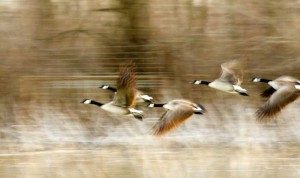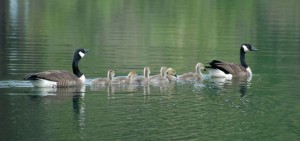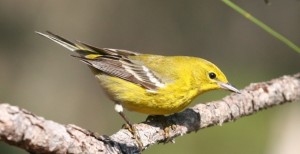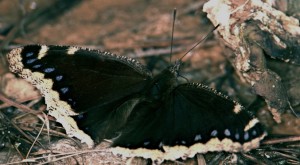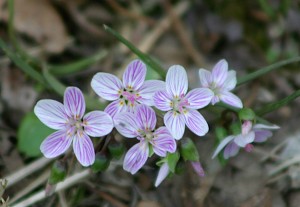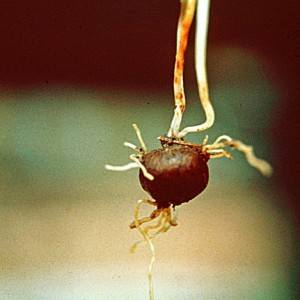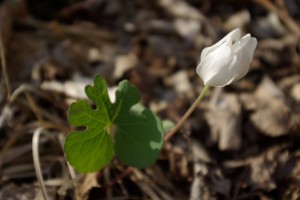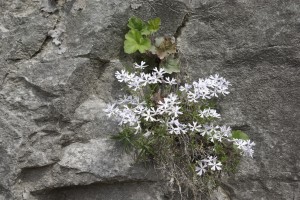Geese Trumpet and Call In the Spring
Canada geese truly herald and trumpet the arrival of spring over the bluff lands of Monroe, St. Clair, and Randolph Counties. Conservationist and hunter Aldo Leopold said it best in 1940 with the observation “…one skein of geese, clearing the murk of a March thaw, is the spring.”
Canada geese are very much family creatures. They mate for life. Flocks, often numbering 30-100 individuals, are made up entirely of extended family members, with brothers and sisters, aunts, uncles and cousins all in the gaggle, led by the eldest patriarch at the head of the distinctive V-formation.
The establishment of wetland refuges and the increase in corn-producing acreage over the last half-century have encouraged new generations of geese to stay year-round rather than migrate to Canada for the breeding season. Our upland sinkhole ponds and lakes and the wetlands in the bottoms now host permanent resident geese flocks. Even during breeding season their extended family linkages are at work. The geese practice a gang brood or “crèche” system — a kind of day care — wherein one pair of adult geese will watch over and train 10-20 little gosling relatives.
Not a loud trumpeting, but the soft refrain of “fee bee, fee bee” sounding near house and barn is another reminder that spring is near. Eastern Phoebes, calling their name, are one of the earliest migratory songbirds, often appearing in mid- to late-March. Phoebes have a great affinity for human-built structures, which offer protective overhangs found in nature at steep stream beds and rock outcroppings in the woods. So long as human landlords are willing, phoebes will nest under eaves or even on top of porch lamps. Their rental payments are made in insect-eating currency as both phoebe parents strive from spring through fall to raise two broods of four to six chicks each time. Just as voracious an insect eater as the better-known Purple Martins, phoebes are more drab in appearance. The seven-inch long birds are brownish gray above, darkest on their head, wings and tail, mostly white below with a buffy olive wash along their breast sides.
Far less drab are the early spring warbler migrants, Northern Parula and Pine Warbler. Both winter just south of our area and begin to push north in March; both will breed here as well as farther north. Northern Parulas are tiny little birdlets — four and one-half inches long — and often stay hidden high in the trees as they search for and devour insects, mites and spiders. The cheerful song — a rising, buzzing upward song often ending with a tickle-up tschriiiip — is a location clue for the person focusing binoculars high on the tree tops while trying to ignore the ache that grows and grows (and known among birders as warbler neck). But patience is well rewarded with a view of this bird’s jewel-like colors: deep blue-gray upper parts extending on the head and sides of the throat, a greenish upper back spot, two white wing bars, bright yellow throat and breast, decorated, on the males, with red and black breast bands, all set off with white belly and undertail feathers.
Sometimes easier to see are Pine Warblers which will come to bird feeding stations early in spring when their insect foods are less readily available. These aptly named birds nest in pine groves. Slightly longer than five inches, pine warblers have olive green upper parts, yellow breast and throat, white belly and undertail feathers and two white wing bars.
While songbirds migrate along broad fronts, other migratory birds follow more constricted pathways, perhaps best described as highways or rivers in the air. Among these are the shorebirds, some of the greatest-distance migrants known, which begin to travel to and through our area in March and April. Our rich bottomlands provide rest and refueling stops along the migratory journey up the Mississippi River flyway. Pectoral sandpipers, sometimes called “grasspipers” because they pause to eat and gain strength in wet fields and mudflats as they travel from South American wintering grounds to breeding areas along the Canadian and Alaskan north coasts. Flying along the same highway are many other shorebird species, making their way from continent to continent by taking advantage of our rest stop area. Our resident shorebirds — Killdeers — of course, have little need of actual “shores,” and nest in fields, near roads and farmsteads.
Just about the time that Killdeers begin to call in spring, Mourning Cloakswill be the first butterflies out and about in the bluffs on our first warmer days in March. They are Illinois’ longest living butterfly, with a lifespan of one year. Their four inch wingspan, dark brown color with a purplish cast, and slow, fluttery flight pattern make them easy to spot. They are among the earliest breeders, mating in March or April. After mating, females lay eggs on the branches of our numerous hackberry or elm trees. Shortly after, the adults die. The butterfly larvae feed on new tree leaves and by June or July metamorphose into adult Mourning Cloaks, which overwinter, hibernating in hollow logs or in tree holes. And then, on a warm March day, they awaken, search for mates, and begin the cycle all over again.
Spring beauties will begin to bloom on the moister north slopes and in the ravines of the bluff woods in March. The four to six inch plant, with two grass-like leaves, has beautiful five-petaled, one-half inch wide, pink flowers striped in deeper shades of pink. Amerindians and our first European settlers ate the corms. These “fairy spuds” reportedly taste like radishes when eaten raw; if boiled, like chestnuts. Wild turkeys love them and will scratch the soil to dig up the treats.
Bloodroot will bloom in March. The low-growing plant has eight-petaled, large, three-inch across, white flowers, with bright yellow stamens. The flowers only last one or two days. Bloodroot, which can be found along the moist creek hollows of the bluffs, was given its name for the red juice of its stems and roots. Native Americans used it for a fabric dye and paint, and taught this to the early French settlers who exported the roots back to France via the Mississippi. Early Virginia settlers also boiled the roots to make a cough medicine. Today, bloodroot is grown commercially for use as an additive in toothpaste and mouthwash.
Cleft phlox also blooms in March. A short, mat-forming plant, with five-petaled, deeply notched, light blue flowers, it clings to the limestone ledges of the bluffs. Large swaths of cleft phlox on the bluff face above and south of Prairie du Rocher can be easily seen from Bluff Road and, if the light is right, give the appearance of patches of blue sky fallen to earth, further beautifying our unique bluff lands.
© 2007 all content rights reserved, Clifftop NFP.
Comments are currently closed.

